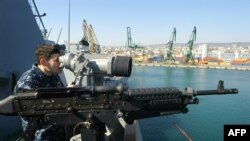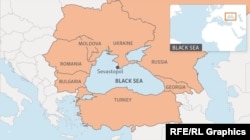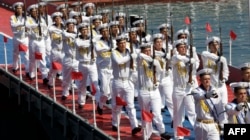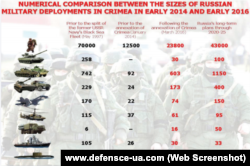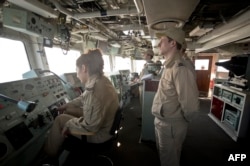Ambassador Anatoly Antonov was referring to the mid-February deployment of the U.S. guided-missile destroyer USS Carney to the Black Sea, where it joined the destroyer USS Ross. It was the first time the two warships deployed in the area simultaneously after participating in drills in the area in July.
Equipped with the Aegis Ballistic Missile Defense System, the ships are forward deployed to Naval Station Rota in Spain but on this deployment have docked at the Varna and Constanta ports in Bulgaria and Romania, respectively.
U.S. Vice Admiral Christopher Grady, commander of the 6th Fleet, said the decision to deploy two warships was “proactive, not reactive.” The deployment, he said, shows “enduring commitment to regional stability, maritime security of our Black Sea partners, and the collective defense of our NATO allies,” noting that the U.S. operates “at the tempo and timing of our choosing.”
U.S. military officials said the move was intended to “desensitize Russia to the presence of U.S. military forces there,” and to help advance rules guiding a safe operation of the states’ warships.
Contrary to Antonov’s remarks, the former commander of Russia’s Black Sea Fleet Admiral Vladimir Valuev stated that the warships “don’t pose any particular threat” to Russia. “If they demonstrate any hostile or provocative actions…they will get a response and will be served accordingly,” he said in a statement.
Russia has on numerous occasions protested such deployments in what it regards as its own backyard and has also engaged in buzzing of U.S. vessels and close aerial encounters that the U.S. labels as “unsafe.”
Paul Coyer, a research professor at the Washington D.C.-based Institute of World Politics, explained: “Russia’s attempt to dominate the region and block the United States Navy from cooperating with the navies of littoral states [those with Black Sea shorelines] worried about Russian control of the Sea has led to Russia undertaking actions that seek to dissuade American ships operating there, such as dangerous passes by Russian warplanes over U.S. navy ships and other intimidation attempts.”
Nikolay Antoshkin, former deputy commander of the Russian air force, questioned U.S. military activities in the Black Sea, which is enveloped by Russia but also Turkey, Bulgaria and Romania, which are members of NATO, as well as U.S. partner states Georgia and Ukraine. (Turkey controls the narrow straits leading to the sea.)
“Americans have nothing to do in the Black Sea. This is an enclosed sea,” Antoshkin stated, commenting on an incident in November 2017, when a U.S. jet tried to evade an oncoming Russian aircraft above the Black Sea. The Pentagon then described the Russian maneuver as unsafe.
In 2016, Turkish President Recep Tayyip Erdogan said the Black Sea had almost become “a Russian lake,” despite the fact that several NATO states have significantly larger coastlines and because Russia embarked on an unprecedented naval build-up in the area after annexing Crimea.
The Crimean peninsula is home to Russia’s Black Sea Fleet, which includes some of the naval assets Russia seized from Ukraine during its hybrid warfare operations that resulted in Crimea’s annexation in 2014 – an event Antonov characterizes as “Crimea’s return to the Russian harbor.”
Russia has since engaged in an unprecedented buildup of naval resources in the Black Sea, prompting NATO allies to engage in reconnaissance, including by sending warships to the area, given Russia’s lack of transparency. “Basically anything new that they have they are putting in Crimea,” a U.S. defense official said, commenting on Russia's military activity.
Russia’s interest in controlling the Black Sea has “an understandable strategic rationale,” according to Coyer. But he said the “dramatic expansion of Russian military power” sets others on edge, making it crucial for NATO to undertake deterrence and reassurance initiatives, especially since Bulgaria and Romania, both NATO members, do not have sufficient naval capabilities.
“The U.S. is sending a message that it will defend its allies, uphold maritime laws and protect its offshore interests in Europe and Asia,” Jim Holmes, strategy professor at the Naval War College, says, adding that “we will not be deterred from going into those waters, and doing so in force.”
Yevgeny Serebrennikov, the first deputy chair of the defense committee of the Federation Council, the upper house of Russia’s parliament, has branded accusations of Russia’s military build-up “direct lies” and “attempts to divert attention away from the U.S.' s own build-up of armaments and military presence.”
However, such arguments do not add up, as U.S. naval operations in the area are constrained.
According to the 1936 Montreux Convention, non-littoral states are not allowed to deploy their warships in the Black Sea for more than 21 days at a time. They also face other restrictions regarding tonnage and the number of ships, among others. This is why the U.S. and other NATO member states have deployed their warships on a rotational rather than permanent basis.
Moreover, some argue that NATO lacks a long-term and sustainable strategy toward the Black Sea region, saying that port visits, regional military exercises, and short deployments of warships alone are insufficient measures to address the changed balance of power in the region.
Unlike Russia, the U.S. cannot build up naval forces in the area by virtue of geography, instead seeking to augment relatively deficient military capabilities of the littoral states. In 2016, NATO adopted its Tailored Forward Presence initiative aiming to increase its presence in the Black Sea in response to Russia’s unprecedented militarization of Crimea. The initiative involves land, air, and sea deployments of NATO allies to check Russia’s build-up.




